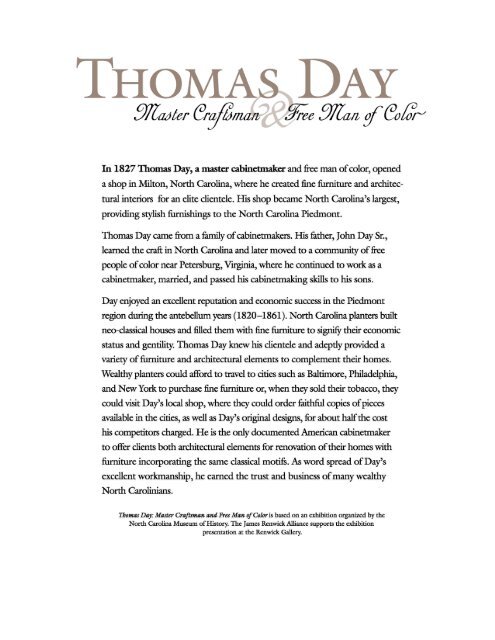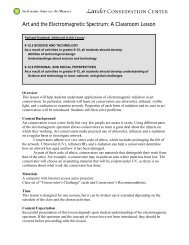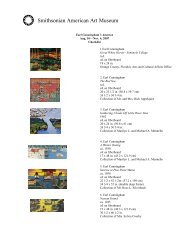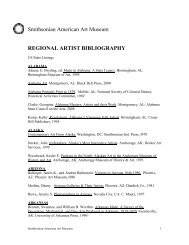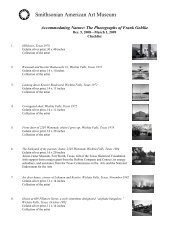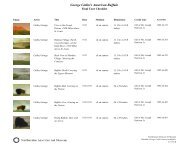Exhibition Wall Text - Smithsonian American Art Museum
Exhibition Wall Text - Smithsonian American Art Museum
Exhibition Wall Text - Smithsonian American Art Museum
You also want an ePaper? Increase the reach of your titles
YUMPU automatically turns print PDFs into web optimized ePapers that Google loves.
The Petition to the Assembly<br />
When Thomas Day married Aquilla Wilson in 1830, she lived in Virginia and by law, was not allowed to<br />
move to North Carolina. If the couple had moved to the North, the town of Milton would have lost a very<br />
talented cabinetmaker. Day’s supporters, including doctors, lawyers, politicians, merchants, and artisans—<br />
many of them members of the Milton Presbyterian Church, which Day attended---signed a petition<br />
directed to the state Assembly requesting that Aquilla Wilson Day be allowed to enter North Carolina. As<br />
a result, the General Assembly passed a special bill allowing Aquilla Day, a free person of color, to enter<br />
the state and live there. Many of these church members had already purchased Day’s furniture for their<br />
homes.<br />
Pew bench, Traditional style, made for a rural church attended by John and Keziah Wilson, Caswell<br />
County, Receipt #4961.1<br />
1835–1845<br />
yellow pine<br />
In 1837 church elders asked Thomas Day to make new pews for the Milton Presbyterian Church; though<br />
this pew is from a different church, the pattern and construction are similar to those used in Milton.<br />
Collection of the North Carolina <strong>Museum</strong> of History, Purchase, funds provided by William S. and<br />
Virginia Powell<br />
Quote:<br />
“If you have done right and acted deservingly it has been Just what you Owe to your self & to your<br />
Creator and to the world.” — Thomas Day to his daughter, November 27, 1851<br />
The Milton Presbyterian Church<br />
Thomas Day had a close connection to the Milton Presbyterian Church. When the congregation planned<br />
construction of a new building in 1837, elders asked him to make pews for the new church. A template<br />
for a pew armrest survived in Day’s shop for 150 years; the pew in this exhibition is from a nearby rural church<br />
and is similar to those made for Milton. In 1841 the church accepted Thomas and Aquilla Day into their<br />
spiritual community as members. In a gesture of social inclusion, Day and his wife sat not in a segregated<br />
area, but among the white congregation, and when he encouraged his slaves to join the church, he<br />
received support from church members. Thomas Day maintained a close relationship with the minister,<br />
the Reverend N. H. Harding, who gave him a personally inscribed Bible.<br />
Fine and Fashionable Furniture<br />
Day’s success was due in part to his ability to work in a variety of styles and produce a large volume of<br />
work quickly. Thomas Day proclaimed that his furniture was “in the newest fashion, and executed in the<br />
most faithful manner.” Nineteenth-century <strong>American</strong> furniture was heavily influenced by popular styles in<br />
Europe and Great Britain, which came to America as finished pieces of furniture or design books, and<br />
also by migrating cabinetmakers who worked in cities along the Atlantic coast. Day consistently<br />
produced new designs to attract and retain clients.<br />
Thomas Day’s Scroll Motif<br />
During the first half of the 1800s, the scroll was an essential component of classically inspired furniture.<br />
Philadelphia cabinetmaker Anthony Quervelle used variations of the popular motif in his work, and<br />
Baltimore cabinetmaker and architect John Hall featured scrolls in his 1840 cabinetmaking book. They<br />
became an integral part of Thomas Day’s artistic design. Day’s distinctive scroll is modest in proportion,<br />
with the outer edge ending almost as abruptly as it begins. Day himself preferred a tight scroll presented in<br />
a plain fashion, but for some of his clients he created an exaggerated scroll. Regardless of the approach,<br />
this motif is an exuberant expression of his creative genius.<br />
<strong>Smithsonian</strong> <strong>American</strong> <strong>Art</strong> <strong>Museum</strong> Page 2 of 8<br />
<strong>Wall</strong> <strong>Text</strong>, Thomas Day: Master Craftsman and Free Man of Color<br />
4/4/13/cr
Thomas Day’s Exuberant Style<br />
Thomas Day welcomed the French Antique style with its penchant for abundant displays of intricate<br />
scrolls paired with fruit and foliage designs. His 1850s advertisements refer to his fine French bedsteads,<br />
sofas, and chairs. Day transformed the French Antique style into one that only he can claim ownership<br />
of—Day’s Exuberant style. His furniture challenges the eye to determine where the primary design motif<br />
lies—in the solid wood or in the negative space.<br />
Dining table, Classical style, made for Dr. John Tabb Garland and Christina Glenn Garland, Caswell<br />
County<br />
about 1835<br />
mahogany veneer over yellow pine and walnut<br />
Day copied the design for the bases of this table from Philadelphia cabinetmaker Anthony Quervelle. The<br />
full table is a double pedestal design, and is ninety-one inches long when fully extended.<br />
Collection of the North Carolina <strong>Museum</strong> of History, Donation, acquired as a donation from the North<br />
Carolina <strong>Museum</strong> of History Associates and the Sir Walter Cabinet<br />
Pair of pier tables with mirrors, Exuberant (French) style, made for Judge Allen Gwyn, Caswell<br />
County<br />
1853–1860<br />
mahogany with mahogany veneer over yellow pine<br />
By the 1850s the parlor was the heart of the home and a fashionably furnished parlor was a sign of<br />
social status. By day, the lady of the house received friends there to discuss community news and<br />
events or oversaw children as they received instruction in needlework or drawing. At night the family<br />
gathered in the parlor for games, musical performances, or literary recitations. Wealthy families<br />
furnished their parlors with the finest furniture, art, and silver to impress their peers.<br />
Loan, Oakwood Inn, Doris and Gary Jurkiewicz, proprietors<br />
Bright Scene of Cattle near Stream, Edward Mitchell Bannister<br />
late nineteenth century<br />
oil on canvas<br />
Edward Mitchell Bannister, an African <strong>American</strong> artist who lived in Boston and Providence, Rhode<br />
Island, had limited formal training but attained great success as a painter. His Under the Oaks was<br />
accepted into the Centennial Exposition in Philadelphia in 1876 and won the first-prize bronze medal.<br />
<strong>Smithsonian</strong> <strong>American</strong> <strong>Art</strong> <strong>Museum</strong>, Gift of Melvin and H. Alan Frank from the Frank Family Collection,<br />
1983.104.2<br />
Rocking chair, Grecian style, made for the Alston family, Aspen Hall Plantation, Chatham County<br />
1855–1860<br />
mahogany, mahogany veneer over yellow pine, and poplar<br />
The Alston chair has two fully articulated scrolls that spring from beneath the arms. Both the arm and its<br />
supports terminate in a tightly carved scroll topped by yet another scroll that arches upward. Day gave<br />
dimension to the rocker by carving an upturned scroll at its front tip. When the chair is in use, the overall<br />
effect of these multiple scrolls suggests the constant motion of ocean waves.<br />
Collection of the North Carolina <strong>Museum</strong> of History, Purchase, state funds<br />
Whatnot, Exuberant (French) style, made for John Wilson Sr., Milton, Caswell County<br />
1853–1860<br />
<strong>Smithsonian</strong> <strong>American</strong> <strong>Art</strong> <strong>Museum</strong> Page 3 of 8<br />
<strong>Wall</strong> <strong>Text</strong>, Thomas Day: Master Craftsman and Free Man of Color<br />
4/4/13/cr
Thomas Day expressed great stylistic exuberance in this whatnot. The shelves are backed by pierced<br />
galleries above and below a center drawer. Cut from three-quarter--inch boards, the pierced galleries boast<br />
sinuous S curves, thumbs, and scrolls. Day’s fluent use of positive and negative space gives the piece a<br />
sense of movement.<br />
mahogany, mahogany veneer over yellow pine, poplar, and walnut<br />
Loan, Margaret Walker Brunson Hill<br />
Quote:<br />
“It is not pleasant to have any thing in the way of Furniture like an Eyesore. I will make all to soot.”<br />
— Thomas Day, 1853<br />
The Grecian Style<br />
Classically inspired designs enjoyed wide popularity during the early 1800s and appeared in most of<br />
North Carolina’s larger cities, such as Raleigh. The Grecian style emerged as the first truly national<br />
style after John Hall, a Baltimore cabinetmaker and architect, published The Cabinet Maker's Assistant,<br />
a book of furniture and architectural designs with distinctive combinations of classical pillars and<br />
scrolls. Thomas Day likely owned a copy and studied its suggestions for furniture designs, which he<br />
enhanced with his own motifs. The fashion for Grecian furniture was part of a broader attraction to<br />
Greek Revival style that dominated the building trades. Many planters built new homes or renovated<br />
existing homes with new interior elements. Day is the only <strong>American</strong> cabinetmaker who has been<br />
documented as offering his clients both boldly Grecian architectural components and sculptural<br />
furniture in the Grecian style.<br />
Thomas Day produced a variety of forms in the Grecian style. His side chairs display different<br />
combinations of Grecian ogee scrolls and serpentine curves. Day often cut a handgrip in the crest rail at<br />
top using a series of undulating curves. The handgrip fits the human hand perfectly, making it easier to<br />
move the chairs from room to room.<br />
Side chair, Exuberant (French) style, made for Ezekial Jones, Caswell County<br />
1850–1860<br />
mahogany<br />
Day experimented with the Rococo Revival style in a set of furniture made for Ezekial Jones that<br />
included two small sofas and six balloon-back chairs. He gave the chairs exaggerated curves and<br />
applied his signature motifs of carved rosebuds and dogwood flowers flanked by tightly scrolled,<br />
upturned thumbs.<br />
Collection of the North Carolina <strong>Museum</strong> of History, Donation, North Carolina <strong>Museum</strong> of History<br />
Associates<br />
Side chair, Exuberant (French) style, made for the James Poteat family, Forest Home Plantation,<br />
Caswell County<br />
1855–1860<br />
rosewood veneer, mahogany, faux rosewood finish over walnut, and poplar (upholstery not original)<br />
Day worked often in the Exuberant style, including this side chair made for Captain James Poteat. Day’s<br />
chair has a subtle balloon-back form with saber front legs. A carved rosebud flanked by tobacco leaves<br />
embellishes the crest rail and the cross rail is composed of his signature thumb scrolls in both the positive<br />
and negative spaces. This playful design with its careful balance of forms is a shining example of Day’s<br />
unique aesthetic.<br />
Collection of the North Carolina <strong>Museum</strong> of History, Donation, Mrs. Priscilla Poteat Upchurch<br />
<strong>Smithsonian</strong> <strong>American</strong> <strong>Art</strong> <strong>Museum</strong> Page 4 of 8<br />
<strong>Wall</strong> <strong>Text</strong>, Thomas Day: Master Craftsman and Free Man of Color<br />
4/4/13/cr
Living Free<br />
While the North Carolina assembly passed restrictive laws, local communities determined when—or<br />
whether—to enforce these laws, sometimes quietly ignoring the law and choosing not to impose certain<br />
restrictions on free people of color. In Milton, local citizens provided significant support for Day’s<br />
business and for his family.<br />
As the wealthier majority controlled the marginal classes, Day navigated complex social demands to<br />
realize his family’s desire to live free. Day was a devoted family man in private, while in public he was<br />
an entrepreneur and artisan who expanded his business and invested in property. Over a thirty-year period,<br />
Day employed white and mixed-race journeymen, apprentices, and common laborers, as well as slaves,<br />
in his shop. Because of the constant turnover of contract workers, enslaved artisans may have been Day’s<br />
steadiest source of labor.<br />
Sofa, Grecian style, made for Governor David S. Reid, Rockingham County<br />
1845–1855<br />
mahogany with mahogany veneer over yellow pine (upholstery not original)<br />
Day makes liberal use of ogee and reverse ogee shapes in this sofa to highlight the gleam of expensive<br />
mahogany. A large vertically set ogee leads to each arm support; this visual line is reversed at the feet.<br />
Day sketched an ogee molding on a piece of stock that eventually became the cap for the arm support<br />
in this piece.<br />
Collection of the North Carolina <strong>Museum</strong> of History, Purchase, funds provided by Delta Sigma Theta<br />
Sorority Inc.<br />
Open-pillar bureau, Grecian style, made for Governor David S. Reid, Rockingham County<br />
1855<br />
mahogany, mahogany veneer over yellow pine, and poplar<br />
Thomas Day used the furniture forms in John Hall’s pattern book as a guide, and adapted them to create<br />
designs that suited his client’s needs and his own aesthetic. Although Day used the same basic form for<br />
bureaus for Governor David S. Reid and Caleb Richmond, the individual motifs and elements he applied<br />
to each furniture piece made them distinctive. Likely, one of the journeymen marked the case back with<br />
Richmond’s name to distinguish this piece from other bureaus in the shop.<br />
Collection of the North Carolina <strong>Museum</strong> of History, Purchase, funds provided by Delta Sigma Theta<br />
Sorority Inc.<br />
Wardrobe, Classical style, made for Green D. Satterfield, Roxboro, Person County<br />
1854<br />
poplar and yellow pine with scroll interior<br />
Mid-nineteenth-century houses did not have closets, so wardrobes were used instead. In this<br />
example, Day uses many time-honored classical elements, such as the split columns, the ring and<br />
ball feet, and paneled doors and sides. But his interpretation of a classical pediment incorporates<br />
graceful curves and soft angles. The wardrobe is also designed to be easily assembled and<br />
disassembled.<br />
Collection of the North Carolina <strong>Museum</strong> of History, Purchase, state funds<br />
Pedestal bureau, Grecian style, made for Governor David S. Reid, Rockingham County<br />
1855<br />
mahogany, mahogany veneer over yellow pine, and poplar<br />
Thomas Day’s Grecian-style bureaus generally hold a mirror framed with decorative elements, supported<br />
by either pedestals or open pillar supports. They have small drawers and are partially covered with a<br />
<strong>Smithsonian</strong> <strong>American</strong> <strong>Art</strong> <strong>Museum</strong> Page 5 of 8<br />
<strong>Wall</strong> <strong>Text</strong>, Thomas Day: Master Craftsman and Free Man of Color<br />
4/4/13/cr
marble top. The cases incorporate either two small drawers over four full-width drawers or four full-width<br />
drawers. Day experimented with the decorative elements, often using moldings or pillars shaped with<br />
ogee or reverse ogee curves.<br />
Collection of the North Carolina <strong>Museum</strong> of History, Purchase, funds provided by Delta Sigma Theta<br />
Sorority Inc.<br />
Chest, Neat and Plain style, made for the Hatchett family, near Yanceyville, Caswell County<br />
1845–1850<br />
walnut and yellow pine<br />
Day’s blanket chest, made for the Hatchett family, merges British-inspired Neat and Plain design with<br />
German-<strong>American</strong> construction techniques. The chest features exposed dovetail joints reinforced at the<br />
top corners with a pin, and a lid fashioned with battens attached with mortise-and-tenon joints. A side<br />
view reveals sinuous curves and sharp spurs on the bracket feet that create a second design in the<br />
negative space.<br />
Collection of the North Carolina <strong>Museum</strong> of History, Purchase, state funds<br />
Social and Legal Constraints<br />
In antebellum North Carolina, elite planters governed at the top of society, with the support of merchants<br />
and yeoman farmers. Landless whites and poor laborers ranked just above free people of color, <strong>American</strong><br />
Indians, and enslaved African <strong>American</strong>s. According to census records, more than 30,000 free people of<br />
color with either African <strong>American</strong>, <strong>American</strong> Indian, or tri-racial ancestry lived in North Carolina in<br />
1860.<br />
Following slave rebellions in Virginia in 1800 and South Carolina in 1822, North Carolina enacted<br />
restrictive laws that prevented free people of color from migrating into the state, prevented those within<br />
the state from leaving for longer than ninety days, forbade free people of color from marrying slaves,<br />
preaching in public, attending public schools, possessing alcohol, testifying in court against whites, or<br />
owning any publication that might incite slaves to rebel. It was illegal to teach a slave to read or write; nor<br />
could people of color possess a firearm or travel out of their home county unless they first secured a<br />
license.<br />
Lounge, Grecian style, made for the Bass family, Caswell County<br />
1845–1855.<br />
walnut and yellow pine (upholstery not original)<br />
Day made a dozen lounges inspired by designs from English designers George Sheraton and George<br />
Smith. The original form was similar to a sofa, but with one end lower than the other, and with an open<br />
back. Like other rural cabinetmakers, Day adapted the form freely. This example shows a straight back<br />
rail and a liberal use of ogee curves.<br />
Collection of the North Carolina <strong>Museum</strong> of History, Purchase, state funds<br />
Bold Architectural Elements<br />
Thomas Day was one of only a few nineteenth-century designers who offered his clients designs for<br />
architectural elements within a room, along with complementary furniture. Researchers have documented<br />
woodwork that has been attributed to Thomas Day in about eighty homes in rural North Carolina and<br />
Virginia. In the 1850s, Greek Revival was the predominant architectural style in the North Carolina<br />
Piedmont. Large plantation houses in that area, with their columned porches and porticoes, resembled<br />
Greek temples. Day developed a symmetrical plan for each room using patterns that merged the subtle<br />
lines he had developed in his furniture with the robust forms of Greek Revival architecture as he<br />
developed designs for mantelpieces, niches, newel posts, stair brackets, window muntins, door casings,<br />
<strong>Smithsonian</strong> <strong>American</strong> <strong>Art</strong> <strong>Museum</strong> Page 6 of 8<br />
<strong>Wall</strong> <strong>Text</strong>, Thomas Day: Master Craftsman and Free Man of Color<br />
4/4/13/cr
and moldings. His distinctive architectural repertoire evolved over more than twenty-five years and<br />
incorporated myriad influences, from vernacular motifs and Gothic forms to Italianate elements.<br />
Quote:<br />
“The Mind is verry much like any piece of Building or workmanship. It requires many members sootably<br />
arranged to give proper gracefulness & semitry to a building.” —Thomas Day, November 27, 1851<br />
A Workshop Like No Other [Tools of the Trade]<br />
Thomas Day’s workshop resembled no other in piedmont North Carolina. As a free man of color, he<br />
owned the shop and directed the work of white and mixed-race cabinetmakers, journeymen, and<br />
apprentices, as well as slaves. The success of the cabinet shop, which Day had opened in Milton in 1827<br />
and operated for the first twenty-five years of his career, depended upon his skill as a master<br />
cabinetmaker as well as his ability to manage his labor force to produce fine furniture and coffins, as well<br />
as architectural elements such as newel posts, stair brackets, and interior moldings.<br />
<strong>Art</strong>isans like Thomas Day possessed special skills in using hand tools to make fine furniture, which were<br />
acquired by training under an experienced cabinetmaker. Apprentices worked for a master for seven years<br />
as they learned to measure, cut, shape, and join wood. Upon completing their terms as apprentices, they<br />
became journeymen— cabinetmakers with some advanced skills who still worked under a master. Only<br />
after years of work and demonstrated ability could a man earn recognition as a master cabinetmaker.<br />
Day’s men labored at workbenches with tools and early machines powered by hand or foot, including a<br />
wheel lathe, shaving horse, drill press, and treadle saw. They used templates or patterns to produce<br />
common elements. A piece’s design and style dictated the type of finish that the cabinetmaker applied.<br />
The finish on traditional walnut furniture often included beeswax or linseed oil, while mahogany was<br />
usually treated with a varnish made by combining either a vegetable or animal resin, like copal or shellac,<br />
with a solvent, such as spirits of wine or distilled turpentine.<br />
Bedstead, Cottage style, made for the Little Plantation (Fourqurean House), Halifax County, Virginia<br />
1855–1860<br />
yellow pine<br />
During the 1800s English cabinetmakers used sixteenth-century decorative elements like bobbin- and<br />
ring-turned spindles on furniture, calling the style Elizabethan Revival. In America, this fashion was<br />
transformed into the Cottage style, which was widely used in rural homes. Day’s experience operating<br />
a great wheel lathe enabled him to develop a variety of Cottage style designs, which he adapted to<br />
bedsteads and dressing tables to suit the tastes of his clientele.<br />
Collection of the North Carolina <strong>Museum</strong> of History, Purchase, state funds<br />
Rocking chair, Grecian style, made for Governor David S. Reid, Rockingham County<br />
1855–1860<br />
mahogany with mahogany veneer over yellow pine (upholstery not original)<br />
The rocking chairs Day made for Governor David S. Reid display distinctive elements and motifs.<br />
Day applied carved scrolls on the front arm supports, while the crest rail has a central carved handgrip<br />
topped with a rosebud and flanked by stylized foliage that contains one of Day’s signature motifs—<br />
tight, upturned scrolls that resemble thumbs. Day always arranged these scrolls symmetrically in<br />
opposing pairs.<br />
Collection of the North Carolina <strong>Museum</strong> of History, Purchase, funds provided by Delta Sigma Theta<br />
Sorority Inc.<br />
<strong>Smithsonian</strong> <strong>American</strong> <strong>Art</strong> <strong>Museum</strong> Page 7 of 8<br />
<strong>Wall</strong> <strong>Text</strong>, Thomas Day: Master Craftsman and Free Man of Color<br />
4/4/13/cr
Pedestal Desk<br />
1853<br />
wood<br />
Late in 1845 Day received a commission to make a pedestal desk; the resulting piece is very refined and<br />
sophisticated, and Day repeated the design several times. The sloped writing surface creates a triangular<br />
well and the front edge of the slanted top has a soft, undulating profile. The feet are ornate and<br />
dimensional. The opposing scrolls arch gracefully and end in an abrupt curl. Carefully fitted drawers and<br />
compartments are hidden behind the elegant paneled doors.<br />
Loaned by the Town of Hillsborough, given by the family of Thomas Ruffin, desk owner and North<br />
Carolina Supreme Court Justice<br />
<strong>Smithsonian</strong> <strong>American</strong> <strong>Art</strong> <strong>Museum</strong> Page 8 of 8<br />
<strong>Wall</strong> <strong>Text</strong>, Thomas Day: Master Craftsman and Free Man of Color<br />
4/4/13/cr


